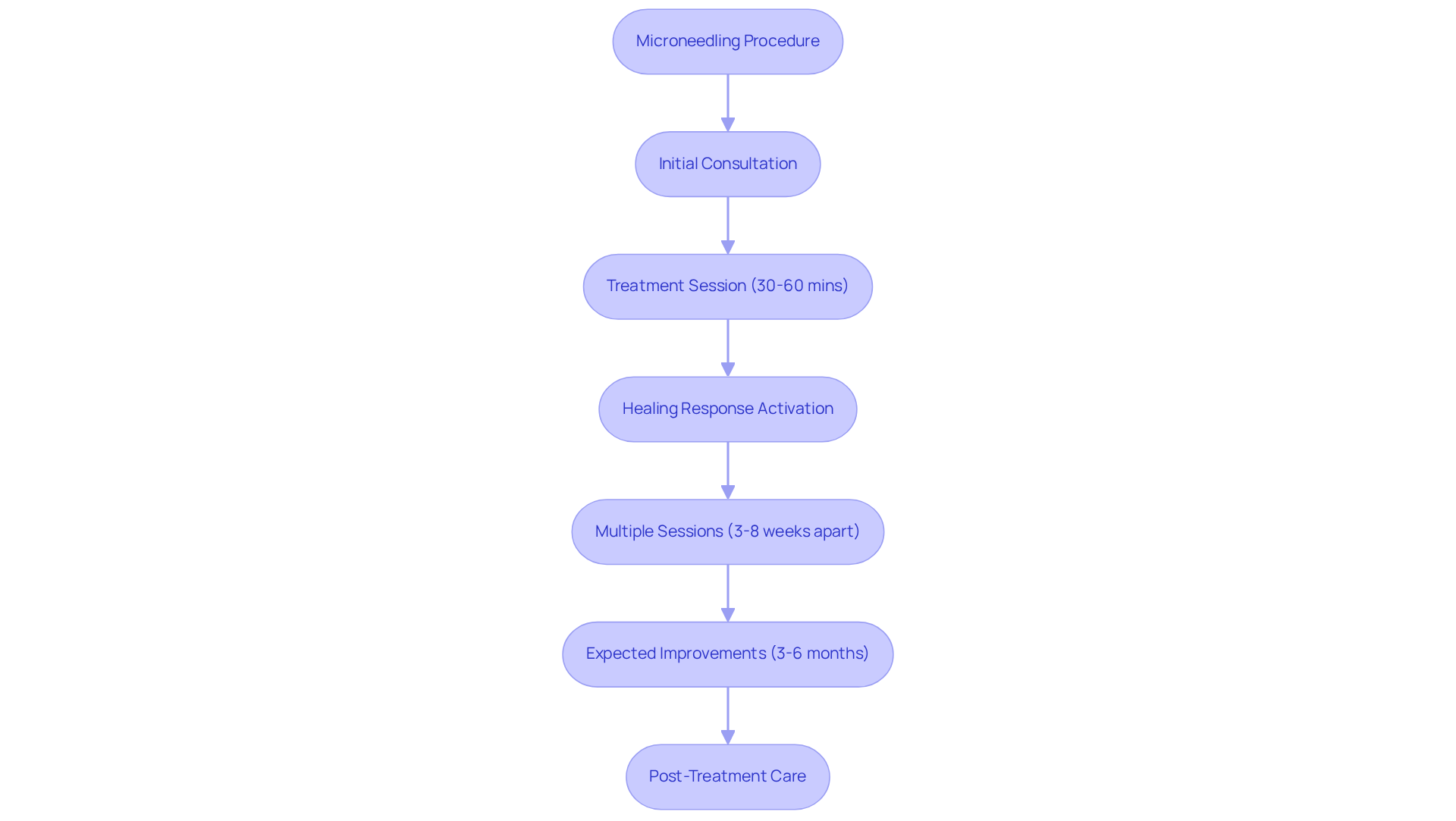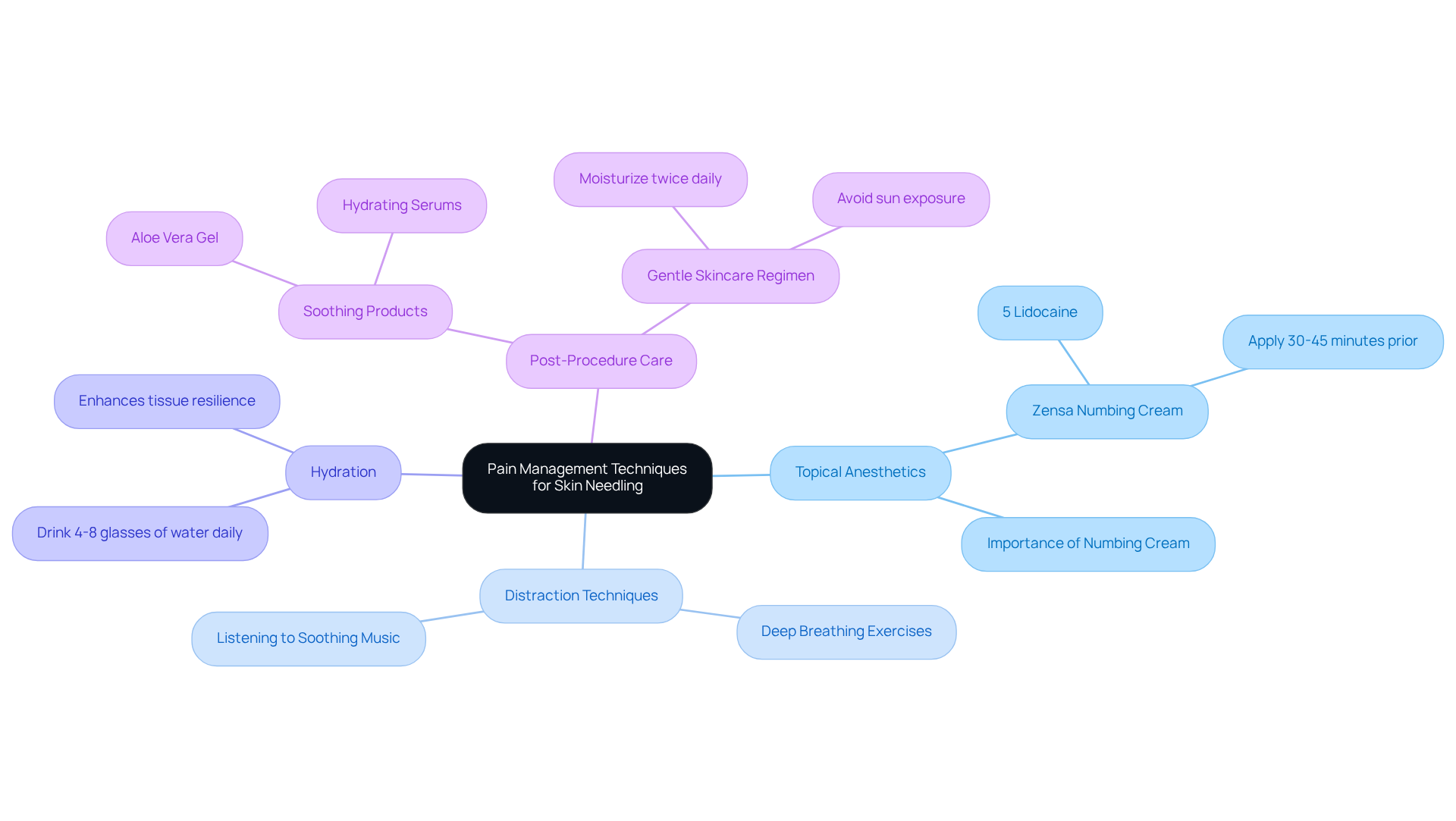Does Skin Needling Hurt? Pain Management and Recovery Explained

Overview
Skin needling, commonly referred to as microneedling, is characterized by only slight discomfort rather than severe pain. Sensations are often described as tingling or prickling, influenced by factors such as needle depth and the application of topical numbing creams.
Pain management techniques play a crucial role in enhancing patient comfort during the procedure. These techniques include:
- The application of numbing agents
- The use of distraction methods
These strategies effectively address concerns regarding pain levels. By implementing these strategies, practitioners can ensure a more pleasant experience, ultimately fostering greater acceptance of the treatment.
Introduction
Microneedling is a cutting-edge cosmetic procedure that has garnered significant attention for its remarkable ability to rejuvenate the skin through the stimulation of collagen production. However, a pressing concern for potential patients remains: does skin needling hurt? Understanding the nuances of pain perception during this treatment is essential, as it directly impacts both the overall experience and recovery process.
To manage discomfort effectively, various techniques can be employed, allowing individuals to prepare for the sensations associated with skin needling. Exploring these questions not only illuminates the intricacies of the procedure itself but also equips readers with the knowledge necessary for a more comfortable journey toward healthier skin. Embrace the opportunity to learn more about microneedling and take the first step toward revitalizing your skin.
Define Skin Needling: An Overview of the Procedure
Microneedling, also known as collagen induction therapy, is a minimally invasive cosmetic treatment that raises the question of whether skin needling hurts, as it employs fine needles to create controlled micro-injuries in the epidermis. This technique activates the body's natural healing response, leading to increased production of collagen and elastin—vital components for enhancing skin texture, reducing fine lines, and improving overall appearance. Typically performed in a clinical setting, the procedure lasts between 30 to 60 minutes, depending on the treatment area.
Research indicates that most individuals require multiple sessions, spaced 3 to 8 weeks apart, to achieve optimal results. Notably, improvements in texture may take 3 to 6 months to fully manifest, making patience a critical aspect of the process. After treatment, patients might question, 'does skin needling hurt,' especially as they experience slight flaking or peeling around days 3 to 5 while the skin surface regenerates.
Dermatologists underscore the efficacy of microneedling for various epidermal concerns, including acne scars and stretch marks, emphasizing its role in promoting healthier tissue. This foundational understanding of microneedling is essential for anyone contemplating the treatment, as it highlights both the benefits and the rationale behind this innovative procedure.

Assess Pain Levels: What to Expect During Skin Needling
Many individuals question whether does skin needling hurt, as pain levels during dermal needling can vary significantly, with most reporting only slight irritation rather than severe pain. This sensation is often described as tingling or prickling, prompting the question: does skin needling hurt, as some liken it to the feeling of passing sandpaper over the skin. Crucially, the depth of the needles influences the level of discomfort experienced, raising the question, does skin needling hurt? Shallower needles, typically ranging from 0.25mm to 1.5mm, generally result in less pain, whereas deeper penetration can produce more pronounced sensations, particularly when targeting scars or deeper wrinkles.
Many clinics employ topical numbing creams prior to the procedure, which usually take about 20-30 minutes to take effect, significantly alleviating discomfort and addressing the question of whether does skin needling hurt. Practitioners stress the importance of open communication regarding pain tolerance, enabling adjustments to enhance the overall experience. Additionally, it is vital to recognize that sensitivity may increase during the menstrual period. Understanding these pain levels and the factors that influence them prepares clients both mentally and physically for the treatment, addressing the question of does skin needling hurt, and ensuring a more comfortable journey toward a revitalized appearance. Post-treatment effects, such as redness and swelling, typically subside within a day or two.

Implement Pain Management: Techniques to Enhance Comfort
To enhance comfort during skin needling, it's essential to address the question of whether skin needling hurts and employ several effective pain management techniques.
-
Topical Anesthetics: Utilizing a numbing cream, such as Zensa Numbing Cream with 5% lidocaine, applied 30-45 minutes prior to the procedure can significantly diminish pain perception. Dermatologists emphasize that this method is crucial for minimizing discomfort during the treatment, which raises the question: does skin needling hurt?
-
Distraction Techniques: Engaging in deep breathing exercises or listening to soothing music can effectively divert attention, helping to lessen any unease experienced throughout the procedure.
-
Hydration: Proper hydration before treatment is vital; it enhances tissue resilience and reduces sensitivity. A specific recommendation is to drink at least 4-8 glasses of water daily in the days leading up to the appointment, contributing to a more comfortable experience.
-
Post-Procedure Care: After treatment, employing soothing products like aloe vera gel or hydrating serums can alleviate discomfort and promote healing. Following a gentle skincare regimen that includes moisturizing twice daily is essential, as the skin may be more sensitive to sunlight and certain skincare products post-procedure.
Implementing these techniques not only fosters a more positive experience during the procedure but also supports the overall recovery process.

Evaluate Post-Treatment Care: Understanding Recovery and Discomfort
Post-treatment care is essential for optimal recovery following SQT Bio-Microneedling with Spongilla spicules. Clients may initially experience redness, swelling, and a sensation akin to a mild sunburn, which raises the question: does skin needling hurt? Minor unease may include a slight prickling or burning sensation, leading to the question of does skin needling hurt, but this typically resolves quickly. To facilitate healing and minimize discomfort, consider the following steps:
- Avoid Sun Exposure: Shield the dermis from UV rays by remaining indoors or using a broad-spectrum sunscreen with SPF 50 or greater. Healing tissue can be light-sensitive for months, making sun protection essential.
- Gentle Cleansing: Use a mild, fragrance-free cleanser for the first few days to prevent irritation. Avoid harsh exfoliants and active ingredients during this period.
- Moisturization: Apply a gentle, hydrating moisturizer containing ingredients like hyaluronic acid or ceramides 2-3 times daily. This aids in retaining moisture and encourages healing, as hydration is essential for recovery of the dermis.
- Avoid Makeup: Refrain from applying makeup for at least 24 hours post-treatment to allow the skin to breathe and recover effectively.
- Avoid Swimming Pools: Stay away from swimming pools for a few days due to irritants and microbes that can affect healing.
Managing discomfort is also vital, especially when asking does skin needling hurt. Experts recommend using soothing products like aloe vera gel or a calming mask to alleviate irritation. Don Mehrabi, MD, FAAD, emphasizes, "Good aftercare is crucial to the success of your microneedling procedure." Adhering to these aftercare guidelines can significantly improve the outcomes of the SQT Bio-Microneedling procedure and ensure a smoother recovery process. Furthermore, it is essential to highlight that Spongilla spicules, utilized in this process, offer crucial nutrients and minerals that promote collagen and elastin production, improving the overall efficacy of the procedure. Clients may experience some flaking or peeling around days 3-5, depending on individual skin conditions and the depth of treatment, which is a normal part of the healing process.

Conclusion
Microneedling, also known as collagen induction therapy, represents a transformative cosmetic procedure that raises critical questions about pain and comfort during treatment. Understanding the nuances of this minimally invasive technique is essential for anyone considering it, as it not only promotes skin rejuvenation but also addresses prevalent concerns regarding discomfort. By exploring effective pain management strategies and post-treatment care, individuals can approach their microneedling experience with enhanced confidence and clarity.
Key points have emerged regarding the pain levels associated with skin needling:
- Most patients report only mild sensations, such as tingling or prickling, particularly when effective pain management techniques—like topical anesthetics and distraction methods—are utilized.
- The significance of post-treatment care cannot be overstated; proper aftercare profoundly influences recovery and overall results.
- By adhering to guidelines such as avoiding sun exposure and using gentle skincare products, patients can enhance their healing process and achieve optimal skin health.
Ultimately, grasping the dynamics of skin needling and its associated pain empowers individuals to make informed decisions about their skincare journeys. With the right preparation and care, microneedling can be a rewarding experience that leads to improved skin texture and appearance. Embracing this knowledge alleviates concerns about discomfort and encourages a proactive approach to skincare, ensuring that each step—before, during, and after treatment—contributes to a successful outcome.
Frequently Asked Questions
What is microneedling?
Microneedling, also known as collagen induction therapy, is a minimally invasive cosmetic treatment that uses fine needles to create controlled micro-injuries in the epidermis, activating the body's natural healing response and increasing the production of collagen and elastin.
How long does a microneedling procedure take?
The microneedling procedure typically lasts between 30 to 60 minutes, depending on the treatment area.
How many sessions of microneedling are usually required for optimal results?
Most individuals require multiple sessions, spaced 3 to 8 weeks apart, to achieve optimal results.
When can improvements in skin texture be expected after microneedling?
Improvements in skin texture may take 3 to 6 months to fully manifest after the treatment.
Is microneedling painful?
Patients often wonder if skin needling hurts, but while there may be some discomfort, it is generally well-tolerated. Some slight flaking or peeling can occur around days 3 to 5 as the skin surface regenerates.
What skin concerns can microneedling address?
Microneedling is effective for various epidermal concerns, including acne scars and stretch marks, and it promotes healthier tissue.
Where is microneedling typically performed?
Microneedling is typically performed in a clinical setting by trained professionals.


